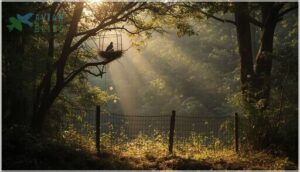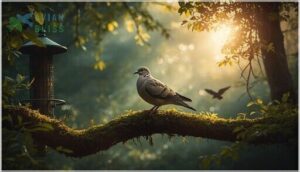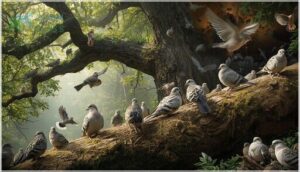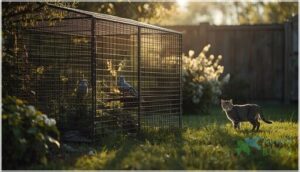This site is supported by our readers. We may earn a commission, at no cost to you, if you purchase through links.

Yet, when conditions tilt in their favor, doves prove astonishingly resilient. Peel back the layers, and you’ll find that how long doves live isn’t as simple as it sounds.
Table Of Contents
- Key Takeaways
- Lifespan and Behavior of Doves
- Dove Species and Predators
- Challenges and Conservation of Doves
- Factors Affecting Dove Lifespan
- Survival Rates and Statistics of Doves
- Threats Posed by Cats to Doves
- Longevity of Doves in Captivity
- Frequently Asked Questions (FAQs)
- How many mourning doves are there?
- How long can a mourning dove live in captivity?
- How long do rock doves live in captivity?
- How long do doves live?
- How long do laughing doves live?
- How long do pigeons and doves live?
- What is the migratory pattern of mourning doves?
- How many eggs does a dove lay per clutch?
- What are some distinguishing features between dove species?
- How do you tell the difference between a male and female dove?
- Conclusion
Key Takeaways
- Most wild doves live just 1.5 to 2 years due to high predation, harsh weather, and human impact, but captive doves can reach up to 19 years with proper care.
- The greatest threats to dove survival are predators like raptors and outdoor cats, along with habitat loss, disease, and lead poisoning from spent ammunition.
- Doves show strong mating bonds and both parents share nesting duties, helping support stable populations even with high first-year mortality.
- Conservation efforts like habitat restoration, predator control, and responsible hunting practices play a crucial role in sustaining healthy dove populations.
Lifespan and Behavior of Doves
Understanding how long doves live requires looking at both their lifespan and the behaviors that shape their survival. Wild doves face vastly different challenges than their captive counterparts, and these differences show up dramatically in how long they make it.
Let’s explore the key factors that determine dove longevity, from their survival rates in nature to their mating habits and seasonal movements.
Wild Dove Lifespan and Survival Rates
When you consider wild dove lifespan in North America, the numbers paint a stark picture. Most mourning doves live just 1.5 to 2 years, and first-year mortality exceeds 70%, meaning only about 20–30% make it past their first year. Hunting impact plays a significant role—kill rates in hunting states are six times higher than elsewhere, accounting for up to 30% of annual mortality.
Regional variations in survival reflect these pressures, though population trends remain relatively stable thanks to high reproductive rates and targeted conservation efforts. The mourning dove population is influenced by factors such as habitat use patterns that affect their overall survival and breeding success.
Captive Dove Lifespan and Differences From Wild Doves
Captive doves live dramatically longer than wild ones—up to 19 years on average, compared to just 1.5 years in the wild. Some dove species’ lifespan records exceed 20 years in captivity, with proper captive care including balanced dove nutrition, avian enclosures, and veterinary attention.
Longevity factors like predator protection and disease management create this stark difference. Conservation methods now incorporate these insights, showing that controlled environments eliminate the threats wild doves face daily. Understanding dove lifespan factors is vital for effective conservation efforts.
Sexual Maturity and Mating Behavior
Doves usually reach sexual maturity between 4 and 6 months, though mourning doves can mate as early as 85 days. You’ll notice males begin their courtship displays with elaborate cooing, tail-fanning, and dramatic flight patterns designed to catch a female’s attention. These mating rituals showcase their fitness and establish territory against rival males.
Once a pair bonds, their partnership strengthens through mutual preening and coordinated movements. Here’s what makes dove reproductive roles unique:
- Both parents share nest-building responsibilities equally
- Males gather twigs while females construct the nest structure
- Incubation duties split between partners throughout the 14-15 day period
- Each parent produces crop milk to feed hatchlings
- Breeding season extends February through October in favorable conditions
Approximately 90% of dove species maintain monogamous bonds during breeding season, with some pairs staying together through winter. If one partner dies, you’ll often see the survivor seek a new mate.
Nesting Habits and Parental Duties
Once paired, you’ll watch your doves construct surprisingly flimsy nests—often just loose twigs barely an inch deep. Both parents share every duty: males incubate by day, females by night during the 14-15 day period. After hatching, they produce nutrient-rich crop milk for the first three days, then switch to seeds.
Nest building happens fast—sometimes under three days—with males gathering twigs while females weave the structure. You’ll notice they reuse successful sites for up to five clutches per season, though survival rates vary dramatically. Natural nests succeed about 44% of the time, while artificial platforms reach 61%. Defense behavior intensifies immediately after hatching, with parents performing distraction displays when predators approach rather than abandoning vulnerable chicks.
| Nesting Stage | Duration | Parental Behavior |
|---|---|---|
| Nest Construction | 1-3 days | Both parents gather materials and build cooperatively |
| Egg Incubation | 14-15 days | Male incubates daytime; female manages nights |
| Early Brooding | Days 1-5 | Nearly continuous brooding by both parents |
| Nestling Period | 12-15 days | Feeding trips increase as squabs grow larger |
| Fledgling Stage | Days 12-14 | Young leave nest; parents continue feeding briefly |
Migration Patterns of Mourning Doves
Each fall, mourning doves begin extraordinary journeys—some traveling up to 2,000 miles from northern breeding grounds to southern wintering areas. Migration routes primarily follow central flyways, with Texas alone hosting 32% of the national migratory population. These migratory birds don’t travel in tight formations; instead, their flock behavior involves loose, dispersed groups that reduce predation risk during long-distance flights.
Here’s how mourning dove migration patterns unfold:
- Timing triggers: Migration begins in mid-August when decreasing daylight—not temperature—signals departure, with birds averaging 15–30 miles daily through September.
- Stopover sites: Doves select croplands and rangelands with abundant seeds, often returning to the same locations year after year to replenish critical fat reserves.
- Flight patterns and habitat selection: Birds follow predictable south and southeast routes, with many overwintering in Mexico and Central America while southern populations remain year-round residents.
You’ll notice strong site fidelity among these migratory birds—they return to identical breeding territories each spring, guided by internal circannual rhythms. This navigational precision ensures dove survival despite facing predators, weather extremes, and the physiological demands of covering hundreds of miles. Their success depends entirely on maintaining adequate stopover habitat along established migration routes.
Dove Species and Predators
North America is home to several dove species, each facing its own set of challenges in the wild. From natural predators lurking in trees and on the ground to threats created by human activity, doves navigate a dangerous world every day.
Let’s look at the different species you might encounter, the predators they face, and what you can do to help protect them.
Different Species of Doves in North America
When you explore North America’s dove species, you’ll find fifteen distinct types, though the Mourning Dove dominates the landscape with an estimated 165 million individuals. The Eurasian Collared-Dove has rapidly expanded across the continent since the 1980s, while White-winged Doves now breed as far north as Colorado. Rock Doves, Inca Doves, and other species fill unique ecological niches, each displaying different habitat preferences.
This species diversity strengthens dove conservation efforts, helping researchers understand how avian research can protect these adaptable birds across varying environments.
Natural Predators of Doves
Raptors like hawks, owls, and falcons are your top avian predators, causing roughly 60% of annual dove mortality through their speed and sharp vision.
Mammal predators—cats, raccoons, skunks—target ground nests relentlessly, with outdoor cats alone killing over 2.4 billion birds yearly.
Snake predation wipes out entire clutches in stealth raids, while corvids and jays exploit vulnerable nests during breeding season, creating substantial predatory threats across all life stages.
Human-caused Threats to Dove Populations
Habitat Destruction from development has eliminated more than 290 million acres of North American grasslands, forcing doves into shrinking refuges. Your local dove populations face mounting pressures beyond natural predators, with human impact on doves reaching critical levels across multiple fronts:
- Lead Poisoning: Doves ingesting 13–19 lead pellets show survival rates dropping to just 8.3% within 21 days, creating devastating mortality in hunted areas.
- Hunting: Annual harvests remove 13.2 million mourning doves, though regulated seasons don’t markedly destabilize populations.
- Pollution Effects: Agricultural pesticides cause fertility reduction, eggshell thinning, and acute toxicity.
- Climate Change: Shifting habitats compound existing dove predators and threats, with turtle dove populations plummeting 99% since the 1960s.
Understanding these human activities helps you support conservation efforts protecting vulnerable species.
Strategies for Protecting Doves From Predators
Predator deterrents work best when you combine multiple approaches. Installing physical barriers around nests boosts survival rates by up to 2.4%, while overhead netting blocks aerial predators like hawks and owls. Your habitat management choices matter too—doves nesting 15 feet high in dense cover face 20% fewer ground predator attacks.
Effective conservation efforts include:
- Motion-triggered cameras for real-time threat assessment
- Propane cannons randomized across feeding areas
- Reflective balloon deterrents reducing predatory events 40%
- Buried perimeter fencing preventing predator breaches
These dove conservation efforts require consistent monitoring and predator control adjustments.
Challenges and Conservation of Doves
Despite their abundance, doves face serious threats that put their survival at risk. From predators and disease to habitat loss and human activity, these birds navigate a challenging world every day.
Understanding what endangers them—and what’s being done to help—shows you how delicate the balance really is.
Listing of Doves as of Least Concern by Conservationists
Despite the threats you’ve read about, most North American dove species hold a Least Concern conservation status according to IUCN rankings. The Mourning Dove, for instance, maintains a healthy population of roughly 346 million individuals as of 2023. Wildlife conservation efforts like habitat restoration and ongoing population monitoring by conservationists help offset predation and disease pressures, keeping these species classification categories stable across global listings.
| Dove Species | Conservation Status | Population Trend |
|---|---|---|
| Mourning Dove | Least Concern | Stable |
| Eurasian Collared-Dove | Least Concern | Stable |
| Common Ground Dove | Least Concern | Stable |
| White-eared Brown-dove | Least Concern | Stable |
| European Turtle Dove | Vulnerable | Declining |
Impact of Human Hunting on Dove Mortality
You might be surprised to learn that regulated hunting contributes less to dove mortality than you’d expect. Banding research shows hunting accounts for roughly 26–30% of annual deaths in dove populations where it’s permitted, with nationwide hunting mortality estimated at 10–15%.
While hunting regulations and practices do impact local mortality rates—especially among juveniles during early seasons—natural causes like predation, disease, and weather still dominate overall dove mortality at rates exceeding 50% annually. Lead poisoning from ingested shot poses an additional survival risk, reducing survival rates dramatically in affected birds.
Conservation-minded hunting practices and nontoxic ammunition help balance harvest traditions with dove conservation needs.
Risks and Vulnerabilities Faced by Doves
Beyond hunting, you’ll find doves facing a gauntlet of survival challenges. Habitat loss from development and farming strips away nesting sites and food sources, while disease outbreaks—like trichomoniasis and avian pox—tear through populations with devastating speed.
Predator attacks from hawks, cats, and snakes claim countless lives, especially among vulnerable juveniles. Human disturbance near nests reduces breeding success, and environmental toxins like lead poisoning slash survival rates dramatically.
These threats to dove populations compound mortality rates that already exceed 50% annually.
Conservation Efforts to Protect Wild Doves
Fortunately, you can support dove conservation through targeted wildlife protection strategies that work. Conservation groups are tackling threats head-on with proven methods:
- Habitat restoration projects like Texas’s prescribed burning programs boost nesting success by 21%
- Species preservation through captive breeding—Socorro doves are slated for reintroduction by 2030
- Dove sanctuaries such as Brazil’s 1,465-acre reserve protecting Blue-eyed Ground-Doves
- Conservation policies including hunting moratoria that increased turtle dove pairs by 25%
- Habitat protection reversing grassland conversion across North America
These conservation efforts directly counter mortality threats you’ve seen.
Factors Affecting Dove Lifespan
A dove’s lifespan isn’t just about genetics—it’s shaped by the world around it. From the places they call home to the diseases lurking in shared feeders, multiple environmental factors determine whether a dove thrives or struggles to survive.
Let’s look at the key influences that can either shorten or extend a dove’s time in the wild.
Influence of Habitat Changes on Dove Lifespan
Habitat changes dramatically shorten dove lifespans by eliminating essential foraging grounds and nesting sites. In central Utah, dove populations plummeted 72% as winter wheat fields—critical feeding areas—declined by 82%.
Habitat fragmentation and urbanization force risky relocations, disrupt migration routes, and reduce reproductive success.
Agricultural intensification, particularly corn and soybean expansion, further decreases juvenile survival rates, creating a cascade of challenges for local dove populations.
Diseases and Parasites Affecting Dove Populations
With doves, health challenges aren’t rare—they run the gauntlet of dove diseases and parasites year-round. You’ll see:
- Trichomoniasis impact: mouth lesions and nestling loss.
- Parasite control made tough by feather mites and nematodes.
- Avian pox and other viral infections recurring annually.
- Disease transmission at crowded bird feeders.
- Weakened flocks unless proactive cleaning and vigilance persist.
Ground Feeding Behavior and Lead Poisoning Risks
A hungry ground-feeder scans bare dirt for seeds but sometimes mistakes lead shot for food. This risk isn’t rare—seed foraging exposes doves to toxic lead ingestion, especially near hunting areas where spent ammunition accumulates.
Even cautious ground feeding can cause lead poisoning, harming dove survival rates, habitat health, and ultimately shortening dove lifespan when hunting impacts go unchecked.
Survival Rates and Statistics of Doves
Knowing how long doves live can feel like piecing together a puzzle, with many factors influencing how their lives unfold. Understanding the odds they face in the wild versus in captivity helps paint the real picture.
Here’s a closer look at the numbers behind dove survival and what shapes their journey.
Survival Rates of Doves in The Wild
What shapes the wild dove lifespan more than anything? Early peril. Up to 75% don’t survive their first year—caught between severe weather and relentless dove predators. Yet, if a bird dodges those first bullets, its odds soar. Here’s a glimpse at dove survival rates:
Most wild doves never make it past their first year, facing deadly weather and relentless predators from the start
| Year | Survival (%) |
|---|---|
| 1 | 25 |
| 2 | 50 |
| 3 | 13 |
Comparison of Captive and Wild Dove Lifespans
Think about this: under Captive Care, a dove’s world turns from “survive the storm” to “dine at leisure.” The difference is dramatic.
The average dove lifespan in the wild is just 1.5 years, due mainly to Wild Survival challenges like predators and severe Habitat Effects. But with attentive management, captive doves reach up to 19 years.
Here’s a side-by-side look:
| Dove Setting | Average Lifespan (Years) |
|---|---|
| Wild | 1.5 |
| Captive | 19 |
| Record Wild | 9 |
| Record Captive | 35 |
| Species Max | 25 |
Contribution of Hunting and Cats to Dove Mortality
Ever wonder what really tips the scales for dove survival—Hunting Impact or the Feral Cat Threat? Here’s the reality: while regulated hunting makes headlines, it’s outdoor cats that silently drive up Mortality Rates. Hunters account for 5–15% of annual dove mortality, but cats—especially feral ones—inflict far greater losses, wiping out billions of birds each year and disrupting natural dove behaviors.
Conservation Efforts need to focus not just on hunting limits, but stringent Predator Control to curb threats to doves where it matters most.
| Threat Type | Mortality Rate | Seasonal/Year-Round |
|---|---|---|
| Hunting | 5–15% | Seasonal |
| Outdoor Cats | Up to 70% | Year-Round |
| Raptors | 10–20% | Year-Round |
| Weather/Disease | 10–20% | Year-Round |
| Other Mammals | 5–10% | Year-Round |
Threats Posed by Cats to Doves
Outdoor cats are a bigger threat to doves than most people realize. Keeping doves safe means thinking about where and how they live.
Here are some practical enclosure options to help protect your birds.
Impact of Outdoor Cats on Dove Populations
It’s hard to overstate the damage outdoor cats cause for doves—killing hundreds of thousands every year and undercutting the success of fledglings and nests. Cat predation is a primary threat to Urban Wildlife and Dove Conservation, making Feral Cat Control essential to any Bird Protection plan. Outdoor cats outnumber native dove predators now, due to habitat loss.
- Outdoor cats decimate dove nestlings and eggs.
- Urban areas heighten cat-driven threats to doves.
- Effective dove conservation must include feral cat management.
Disruption of Mating Rituals and Migration Patterns
Outdoor cats don’t just hunt doves—they unsettle the rhythm of dove mating and migratory patterns, compounding population decline linked to habitat fragmentation and other anthropogenic impacts. You’ll notice their influence in unexpected places:
- Competing for safe nest sites
- Shortened migratory stopovers
- Disrupted flight paths
- Increased nest predation
- Altered nesting behavior as doves avoid urban threats
Longevity of Doves in Captivity
Doves kept in captivity often enjoy much longer lives than their wild relatives, thanks to safer surroundings and steady care. One important part of that care is providing the right living space.
Here are some common ways people house doves when they’re kept as pets or for conservation.
Lifespan of Captive Doves Compared to Wild Doves
Contrast is striking when you look at dove lifespans side by side. Under Captive Care, dove longevity can extend to nearly two decades; in stark contrast, wild doves rarely surpass a year and a half. Safe enclosures remove daily threats—boosting avian health and highlighting how Wild Survival remains a gamble. If you wonder why conservation methods matter, remember: while a captive dove’s lifespan stretches long, the average wild dove lifespan is relentlessly trimmed by predators and harsh realities.
| Environment | Average Lifespan | Highest Recorded Age |
|---|---|---|
| Wild | 1.5 years | 30+ years |
| Captivity | 19 years | 20+ years |
| Wild (rare cases) | 7–12 years | 25 years |
Factors Contributing to Longer Lifespan in Captivity
Dove life in captivity stands apart for several reasons: top-tier Diet Quality, careful Cage Management, and regular Veterinary Care form the backbone of a strong captive dove lifespan.
Add to this Social Enrichment and Environmental Control, and you create a setting where stress plummets and disease risk shrinks—factors affecting dove lifespan far more positively than anything wild birds experience.
Importance of Conservation for Dove Survival
You play an active role in dove survival rates by supporting Habitat Preservation and focused Conservation Efforts. Imagine your actions like threads in a broader web—contributing to Ecosystem Balance and Wildlife Restoration. Every bit counts, whether you invest in Dove Management, foster wildlife conservation efforts, or simply share awareness. Together, we shape the destiny of dove habitat and conservation.
- Support local habitat initiatives
- Participate in community science projects
- Educate neighbors about wildlife conservation efforts
- Help reduce threats from outdoor cats
- Maintain bird-friendly spaces year-round
Strategies for Protecting and Preserving Dove Populations
Through Habitat Restoration, Adaptive Management, and careful Predator Control, you improve dove survival rates and support dove populations. Conservation Planning combined with dedicated ecosystem preservation—and even protecting doves in your backyard—sustains doves for generations. Wildlife conservation efforts thrive when everyone contributes, making your daily choices part of the solution.
| Action | Conservation Impact |
|---|---|
| Plant native plants | Boosts food & shelter |
| Limit hunting | Reduces unnatural mortality |
| Control predators | Lowers nest predation risk |
| Preserve habitats | Maintains stable populations |
| Support local efforts | Builds resilient ecosystems |
Frequently Asked Questions (FAQs)
How many mourning doves are there?
If you think mourning doves are rare, think again—Mourning Dove Estimates for 2025 put their U.S. population at nearly 350 million.
Despite Habitat Impact and shifting Population Trends, this bird species’ abundance justifies its “Least Concern” Conservation Status.
How long can a mourning dove live in captivity?
With proper Captive Dove Care and ideal Dove Nutrition, a mourning dove’s lifespan in a Bird Sanctuary can reach 16 to 20 years. Notable individuals may surpass 30, showcasing Avian Longevity rarely seen in captive birds.
How long do rock doves live in captivity?
Imagine a dove outliving even a cherished family pet—rock doves in captivity can reach 15 to 35 years with consistent Avian Health Management, sturdy Dove Enclosure Design, and a balanced Rock Dove Diet supporting outstanding bird longevity.
How long do doves live?
Dove lifespans vary by environment. Wild doves average just 5 to 2 years due to predators, disease, and habitat loss, while captive doves often reach 15 to 20 years with proper care, food availability, and protection.
How long do laughing doves live?
Think of the Laughing Dove as a survivor in a world of change.
In the wild, these doves may live 5–10 years, although many face steep odds from predators, Dove Diet limitations, and ongoing Habitat Loss.
How long do pigeons and doves live?
Pigeons and doves, especially in urban wildlife, display wide-ranging lifespans. Wild birds average 2-4 years due to predators.
In captivity, with ideal Dove Nutrition and care, bird longevity can soar to 15-20 years or more.
What is the migratory pattern of mourning doves?
As winter approaches, the rhythm of seasonal movements takes mourning doves south along established migration routes.
Remarkably, these migratory birds return each spring to the same nesting sites, showcasing precise flight patterns and a broad geographical distribution across wintering grounds.
How many eggs does a dove lay per clutch?
In each nesting cycle, most doves lay two white eggs per clutch. This consistent clutch size reflects efficient dove reproduction and nesting habits, allowing multiple broods each season.
Both parents share incubation duties in the nesting area.
What are some distinguishing features between dove species?
You’ll spot dove species by their plumage variations—like the soft gray of Mourning Doves or the stark white wing patches of White-winged Doves.
Black neck markings distinguish Ring-necked and Collared Doves, highlighting fascinating species variations and adaptations.
How do you tell the difference between a male and female dove?
If dove dating were a game show, you’d spot males flaunting vivid feather colors, flashier plumage differences, and bold courtship behaviors. Females? Think subtler hues, smaller size variations, and a knack for calm, silent nesting.
Conclusion
Investigate the truth of a theory to help the audience enjoy what’s written. Lifespan, for doves, is far from predetermined fate—it’s shaped by every narrow escape, every shift in the wind, every adaptation to a changing world.
When you ask how long do doves live, imagine each fluttering bird as a living answer, surviving by inches and instincts. These resilient creatures teach us that survival is never guaranteed, yet always worth fighting for, one fleeting moment at a time.
- https://www.wildlifedepartment.com/wildlife/field-guide/birds/mourning-dove
- https://www.cambridgeday.com/2022/10/22/mourning-doves-have-a-mortality-rate-to-cry-over-but-survive-better-than-passenger-pigeon-cousins/
- https://www.britannica.com/animal/mourning-dove
- https://facts4me.com/disp_subject.php?s_id=1234
- https://www.petmd.com/bird/dove-care-sheet












